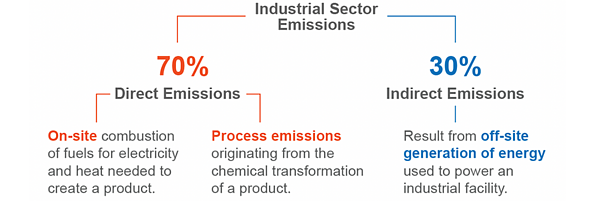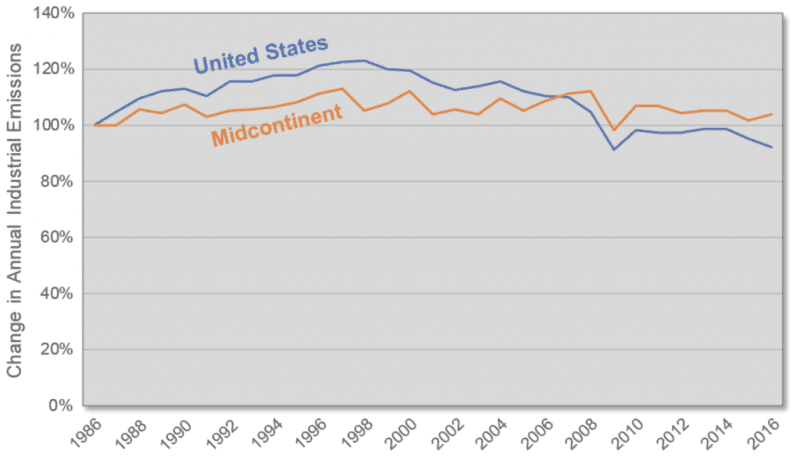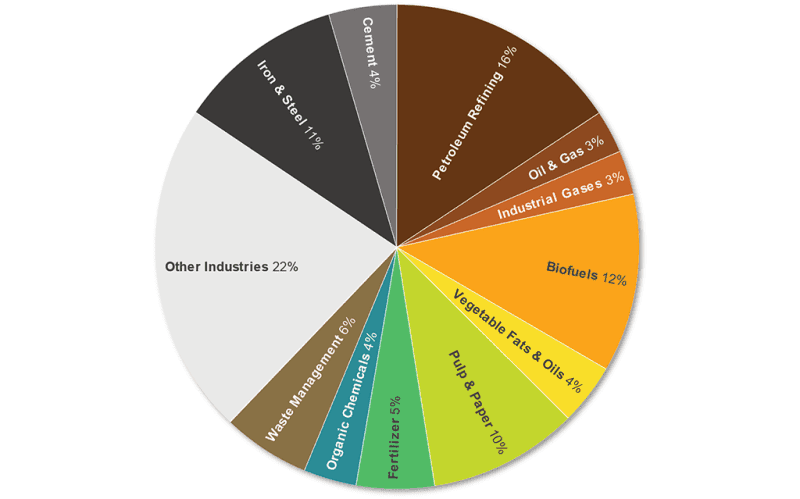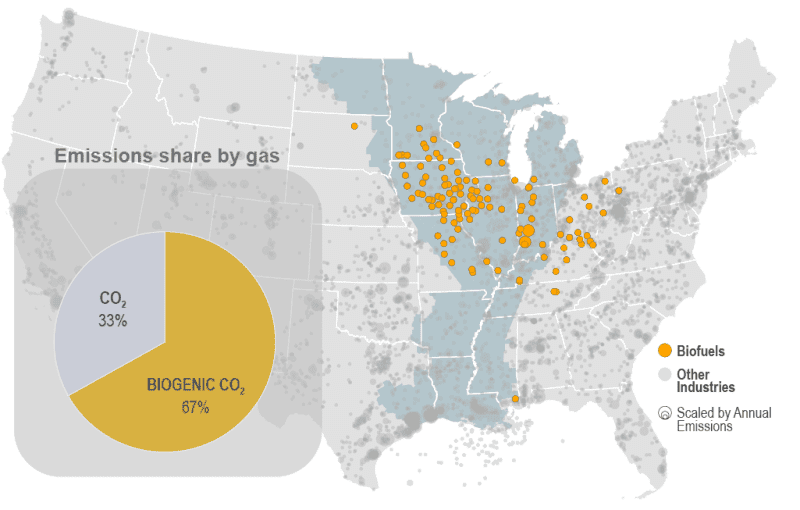Industry is the third highest-emitting sector in the US economy and has less obvious carbon reduction pathways in comparison to electricity and transportation, where the vast majority of decarbonization discussions have focused. This post introduces the current landscape of emissions in the US industrial heartland, the Midcontinent region, to inform discussions of carbon reduction pathways. While industry poses a challenge for decarbonization given its diversity of subsectors, unique emissions sources, and complex solution sets, it also holds a high potential for low-cost strategies, opportunities for collaboration between subsectors, and could drive investment in innovative decarbonization technologies.
Note: The Midcontinent region includes Arkansas, Illinois, Indiana, Iowa, Louisiana, Michigan, Minnesota, Mississippi, Missouri, South Dakota, and Wisconsin.
Here are three key takeaways:
- The Midcontinent region is projected to experience an increase in industrial emissions by 2050 without additional decarbonization policies and strategies.
- The top ten emitting sectors in the Midcontinent account for 70 percent of all industrial emissions in the region. Although this narrows the number of sectors to target for decarbonization, the sources and types of emissions vary within each high-emitting sector.
- The interactive map provided in this post sheds light on localized industrial clusters within the Midcontinent region where beneficial collaboration on decarbonization could occur.
US industrial sector emissions
Industry contributes 21 percent of total emissions in the US economy, making it the third highest-emitting sector. If carbon dioxide (CO2) emissions from the electricity required for the industrial sector (indirect emissions) are also included, the industrial sector is the largest emitting sector in the US economy.
There are two main types of emissions in the industrial sector: direct and indirect emissions. These categories can be helpful in classifying emissions sources to understand each industrial subsector.
The category holding the most emissions in industry is direct emissions. These emissions occur on site at the facility and account for 70 percent of total US industrial emissions. Direct emissions can originate from on-site combustion of fuels for electricity and heat to produce a product or can originate as a result of the chemical transformation of a product, called process emissions. Although process emissions only account for around 25 percent of direct emissions for the industry sector as a whole, some sectors, such as steel manufacturing and cement manufacturing, have process emissions as the majority of their direct emissions. This is an example of the diversity in emissions distributions throughout each industrial sector that makes industrial decarbonization a challenge.
The remaining 30 percent of industrial emissions are from the energy provided by the power sector to produce the goods. Since the emissions occur off site, they are termed indirect emissions. Five of the largest energy-consuming industries (bulk chemicals, oil and gas, steel, paper, and food products) account for over half of the industrial indirect energy use in the US.
Types of industrial sector emissions

The US Energy Information Administration expects the demand for energy from the industrial sector to grow around 34 percent by midcentury and emissions to increase by nearly 18 percent.
Midcontinent industrial sector emissions
Historical industrial emissions in the Midcontinent region show the same pattern of emissions growth over time as the national trend, which suggests this region will also experience an increase similar to the projected 18 percent increase in national industrial emissions.
Growth in industrial emissions for the US and the Midcontinent region, indexed on 1986

The eleven highest emitting industrial sectors in the Midcontinent account for over 70 percent of the total industrial emissions in the region. These top emitting sectors include petroleum refining, iron and steel, waste management, fertilizer, cement, vegetable fats and oils, biofuels, pulp & paper, organic chemicals, industrial gases, and oil and gas extraction (the last three sectors listed are tied for the tenth highest emitter).
Although all top emitting sectors in the Midcontinent can be found throughout the US, the Midcontinent region holds the majority of emissions from three particular sectors: biofuels (74 percent), steel (63 percent), and fertilizer (53 percent). Four of the five highest-emitting states for biofuels are within the Midcontinent region (Iowa, Illinois, Indiana, and Minnesota).
The share of Midcontinent industrial emissions from the top eleven industry sectors

Of these top eleven subsectors, the origin of direct emissions varies greatly. Some sectors have only direct emissions from stationary combustion (starch and vegetable fats, and oils manufacturing), while other subsectors hold the majority of direct emissions in process emissions (waste management, fertilizer, industrial gases, and cement).
Distribution of direct on-site CO2 emissions for the top eleven emitting sectors in the Midcontinent region

For some top-emitting industrial sectors, non-biogenic CO2 is not the main GHG emitted. Methane and biogenic CO2 hold the leading share of GHGs found in waste management and pulp & paper emissions, with direct CO2 emissions accounting for only 5 to 26 percent of the GHG emissions share for each subsector. Biogenic CO2 is also found in biofuels emissions and N2O emissions are prevalent in fertilizer manufacturing. The share of GHG type for each top-emitting industrial sector can be found using the interactive map.
Geographical distribution of Midcontinent industrial emissions
The geographical distribution of the top eleven emitting sectors in the Midcontinent region differs among sectors, but localized industrial clusters are present. The Midcontinent region holds most of the US facilities for two sectors: biofuels (68 percent) and vegetable fats and oils (67 percent). Geographical distributions of the top emitting sectors in the Midcontinent can be explored using the interactive map.

Some industries are evenly spread out throughout the region, such as waste management, while others are found in more localized clusters, such as industrial gases, organic chemicals, oil and gas extraction, and petroleum refining. Areas where localized clusters overlap for multiple industrial sectors, such as in Louisiana and Illinois, may hold opportunities for inter-sector collaboration on decarbonization.
Opportunities for collaboration on industrial emissions reduction
When looking at decarbonizing industry in the US, the industrial heartland of the country—the Midcontinent region—will play a central role. By looking at this region, we can see the unique characteristics of the industrial sector that make it so difficult to target for decarbonization techniques.
Implementation of industry-wide decarbonization clearly presents a challenge; not only does each industrial sector differ in its emissions sources and types, but each sector also has a unique geographic distribution. However, this overview shows that there are opportunities, such as localized industrial clusters, where beneficial collaboration on decarbonization could occur. There are also sectors with similar emissions sources where similar decarbonization strategies could be implemented. By finding and building on these relationships between industrial sectors, we can support effective policies and investments to incentivize the decarbonization of this complicated and essential sector.
Stay tuned for future posts on GPI’s work to decarbonize industry at the regional and federal level by signing up for our monthly newsletter. You can read a previous post about GPI Vice President Brad Crabtree’s Congressional testimony on the role of carbon capture in reducing industrial emissions and a post on our fall 2019 delegation to steel facilities using carbon capture to reduce industrial emissions.

